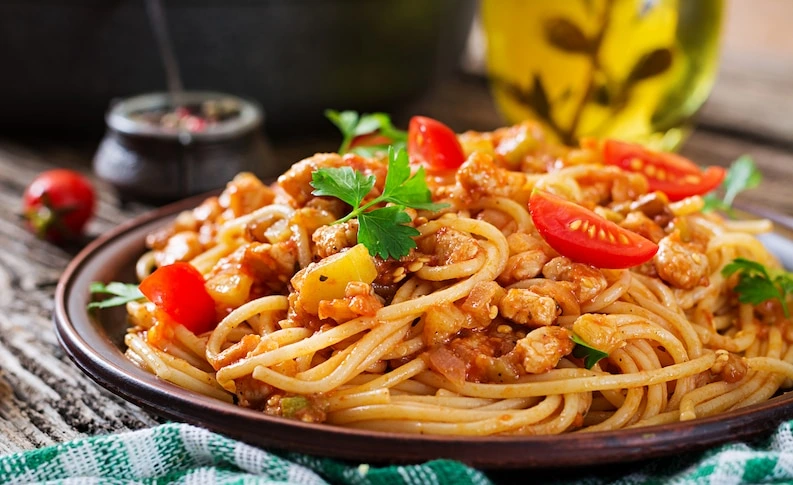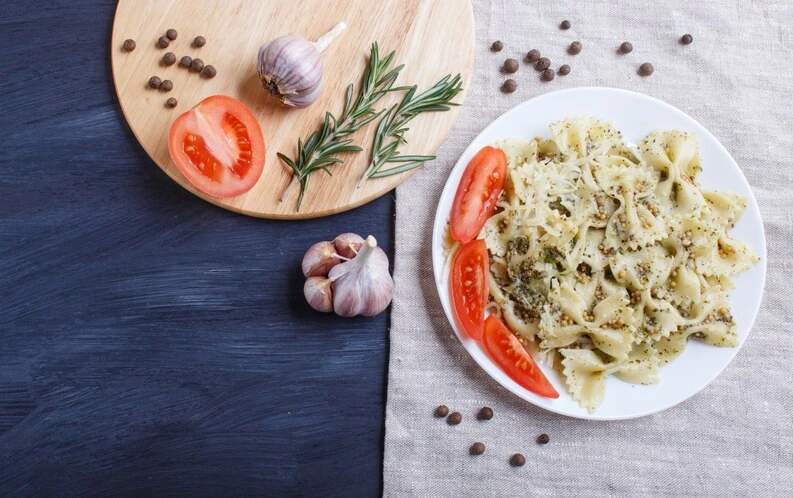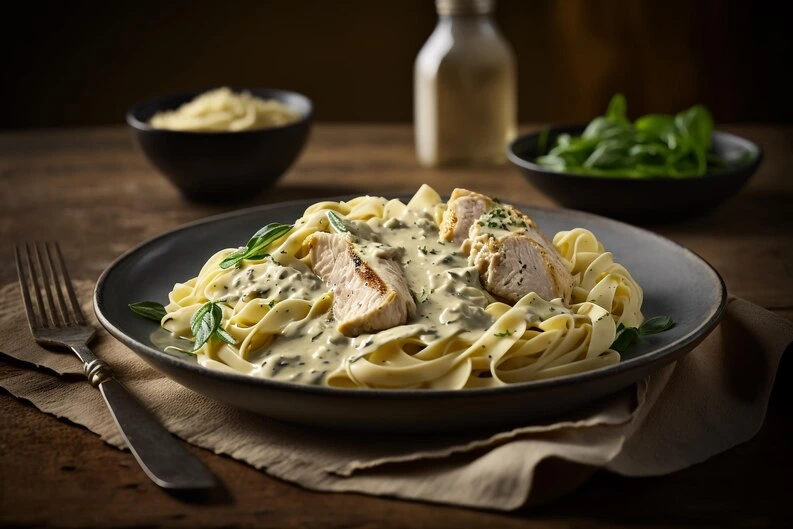Pasta: Irresistible Recipes and Delightful Dishes to Try
Introduction:
Pasta is one of the most beloved dishes in the world, cherished for its versatility and rich history. Whether served with a simple marinara sauce or paired with a decadent Alfredo, pasta remains the ultimate comfort food. Its beauty lies in its simplicity, yet it can be transformed into endless variations, each with its own unique charm.

In this comprehensive guide, we will delve into everything you need to know about pasta, from its fascinating history to the various types available. We’ll also share the best recipes, expert cooking tips, and much more. Whether you’re a beginner or an experienced cook, this guide will help you elevate your pasta dishes to a new level. By the end of this article, you’ll be well on your way to mastering the art of pasta cooking in your own kitchen. Get ready to explore the world of pasta and create delicious meals that will satisfy any craving.
The History
Pasta’s origins are often debated, with both Italy and China claiming to be the birthplace of this beloved dish. While there is evidence that forms of pastta have been made in China for thousands of years, most historians agree that pastta, as we know it today, was developed in Italy.
The earliest mentions of past. in Italy date back to the 12th century, though it wasn’t until the 18th century that it became widespread in Italian cuisine. Initially, it was considered a food for the wealthy, as it required specialized tools for shaping and preparing. Over time, however, pastas production became more streamlined, making it affordable and an essential part of the Italian diet.
Pasta was introduced to the United States in the late 1800s by Italian immigrants, and it has since become a staple in American cuisine. Today, pastas is enjoyed worldwide, appearing in a wide range of dishes—from simple and quick meals to extravagant gourmet creations. It has evolved beyond its humble beginnings into a beloved dish that is adaptable, versatile, and satisfying for all.
Types of Pasta
There are over 600 different types of pasta, each with a unique shape and purpose. Understanding these pasta shapes can elevate your cooking by helping you pair the perfect pasta with the ideal sauce. Below are some of the most popular types:
1. Spaghetti
Perhaps the most iconic of all pastas shapes, spaghetti is long and thin, making it ideal for twirling around your fork. It pairs well with a variety of sauces, especially marinara, meatballs, or simple garlic and oil.
2. Penne
Penne is a short, tube-shaped pasta with diagonal cuts, which helps it capture sauces effectively. Its hollow center allows it to hold onto both hearty meat sauces and creamy Alfredo, making it a versatile choice. Additionally, penne works wonderfully in baked dishes like pasta bakes or casseroles, where its structure ensures every bite is filled with flavor. Its ability to pair well with a variety of sauces makes it a staple in many pasta recipes.
3. Fusilli
Fusilli is a spiral-shaped pasta that’s great for holding onto thick sauces. This unique shape allows the sauce to cling to every twist, making it ideal for pesto or chunky vegetable-based sauces. Furthermore, its texture pairs wonderfully with meat or cheese sauces, ensuring each bite is flavorful. Additionally, fusilli works well in baked pasta dishes, where the spirals trap the sauce for a satisfying experience. Thus, it’s a versatile pasta that adds both texture and flavor to a variety of dishes.
4. Farfalle
Farfalle, also known as bow-tie pasta, is shaped like a butterfly. This unique shape works wonderfully in salads or with light cream sauces. Moreover, its texture holds up well with delicate ingredients like fresh vegetables, making it a great choice for summer dishes. Additionally, farfalle can complement a variety of dressings or light pesto, adding versatility to your pasta options. Therefore, it is an ideal choice for both casual and elegant meals.
5. Fettuccine
Fettuccine is a wide, flat pasta that pairs perfectly with creamy sauces like Fettuccine Alfredo. Its broad shape allows it to hold up well against rich, velvety sauces, making each bite indulgent and satisfying. Additionally, fettuccine works wonderfully with hearty meat sauces such as Bolognese, as its texture absorbs the flavors while maintaining its structure. As a result, fettuccine is a versatile pasta choice for both light and luxurious dishes.
6. Rigatoni
Rigatoni are large, ridged tubes of pasta that are perfect for capturing thicker sauces. Due to their substantial size and grooves, they hold onto hearty tomato-based sauces, meatballs, or chunky vegetable stews exceptionally well. Additionally, their texture allows them to pair beautifully with creamy sauces like Alfredo or rich ragu, making them a versatile choice for a variety of pasta dishes. Consequently, rigatoni is a great option when you’re looking for a satisfying, flavorful meal.
7. Lasagna
Lasagna noodles are wide, flat sheets used in layers for baked dishes. They are most commonly used in classic lasagna, where they are stacked with meat, ricotta cheese, and marinara sauce. Additionally, these noodles can also be used in other baked pasta dishes, such as baked ziti or layered vegetable casseroles. As a result, lasagna noodles are incredibly versatile and provide a hearty base for a variety of flavorful meals. Furthermore, they hold up well during baking, ensuring that each bite is filled with satisfying layers of goodness. Consequently, lasagna noodles are a staple in many kitchens for creating comforting and delicious meals.
Cooking Like a Pro
Cooking pasta may seem simple, but there are several key tips that can help you achieve the perfect dish every time. Here’s a breakdown of the essential steps to cooking it like a pro:
1. Use Plenty of Water
The first step to perfect pasta is using enough water. Ideally, you should use 4 to 6 quarts of water for every pound of pasta. This ensures that the pasta cooks evenly and, consequently, prevents it from sticking together. Moreover, it helps the pasta maintain its texture and absorb the sauce better. By following this simple tip, you’ll achieve the perfect pasta every time.
2. Add Salt to the Water
Adding salt to the water is crucial for flavor. In fact, it helps season the pasta as it cooks and enhances its natural taste. To ensure the best result, a good rule of thumb is to add 1-2 tablespoons of salt for every 4 quarts of water. This simple step will elevate the overall taste of your dish.
3. Stir Occasionally
Once you add the PASTAs to the boiling water, stir occasionally to prevent it from sticking together. This is especially important for long pastas like spaghetti.
4. Cook Al Dente
Al dente means “to the tooth” in Italian, and it refers to pastas that is firm to the bite. Most PASTAs should be cooked al dente for the best texture. Check the PASTs a minute or two before the package instructions suggest to make sure it’s cooked to perfection.
5. Reserve Some Pasta Water
Before draining your recipe, reserve a cup of the cooking water. This starchy water can be used to thicken your sauce or help it adhere better to the pasta.
6. Don’t Overcook
Overcooked pasta becomes mushy and loses its ideal texture. Be mindful of cooking times and always taste your recipe to ensure it’s just right.
Popular Pasta Recipes You Can Make at Home
Now that we’ve covered the basics of pasta types and cooking techniques, let’s dive into some of the most popular pasta recipes that you can easily make at home.
1. Pasta Aglio e Olio
A classic Italian dish, Aglio e Olio is made with garlic, olive oil, chili flakes, and parsley. It’s simple, yet flavorful, and can be made in under 20 minutes. Additionally, this dish is incredibly versatile, allowing you to add ingredients like shrimp, vegetables, or Parmesan for extra flavor. Furthermore, it’s an excellent option for a quick, satisfying meal any night of the week.

Ingredients:
- 12 oz spaghetti
- 4 cloves garlic, thinly sliced
- ¼ teaspoon red chili flakes
- ¼ cup olive oil
- Salt and pepper to taste
- Fresh parsley for garnish
Instructions:
- Cook the spaghetti according to package instructions.
- In a large skillet, heat olive oil over medium heat. Add garlic and chili flakes, cooking until the garlic is fragrant (but not browned).
- Add the cooked recipe to the skillet, tossing to coat in the garlic oil.
- Season with salt and pepper, and garnish with fresh parsley before serving.
2. Spaghetti Bolognese
A hearty meat-based sauce served with spaghetti, this dish is a comfort food favorite.

Ingredients:
- 1 lb ground beef
- 1 onion, chopped
- 2 cloves garlic, minced
- 2 cans crushed tomatoes
- 1 cup red wine
- 1 teaspoon dried basil
- Salt and pepper to taste
- 12 oz spaghetti
Instructions:
- Cook the spaghetti according to package instructions.
- In a large skillet, cook ground beef until browned. Remove excess fat.
- Add onions and garlic, cooking until soft.
- Stir in crushed tomatoes, red wine, basil, salt, and pepper. Let simmer for 30 minutes.
- Serve the Bolognese sauce over the cooked spaghetti.
3. Fettuccine Alfredo
A creamy dish that’s rich and indulgent.
Ingredients:
- 12 oz fettuccine
- 1 cup heavy cream
- 1/2 cup butter
- 1 cup grated Parmesan cheese
- Salt and pepper to taste
Instructions:
- Cook fettuccine according to package instructions.
- In a skillet, melt butter and cook the heavy cream over medium heat for 5-7 minutes until it thickens.
- Stir in Parmesan cheese until melted and smooth.
- Toss the fettuccine in the Alfredo sauce and season with salt and pepper.
Sauces That Perfectly Complement Your Pasta
The sauce is just as important as the recipe itself. First, here are some of the best pasta sauces and tips for pairing them: For example, a rich marinara pairs perfectly with spaghetti, while a creamy Alfredo complements fettuccine. Additionally, a pesto sauce works wonderfully with penne or fusilli, as the ridges capture the sauce. Finally, experimenting with different combinations will help elevate your pasta dishes to new levels.
1. Tomato-Based Sauces
These include marinara and arrabbiata, both of which are perfect for pairing with spaghetti or penne. Furthermore, the acidity of tomatoes balances well with the richness of the pasta. In addition, arrabbiata adds a spicy kick, while marinara offers a more subtle flavor, making them versatile choices for various pasta dishes. Ultimately, these sauces elevate the meal by complementing the texture and flavor of the noodles.
2. Creamy Sauces
Fettuccine Alfredo and Pasta Carbonara are classic creamy pasta sauces. Specifically, they work best with wide, flat pasta like fettuccine, as it allows the rich, velvety sauce to coat each noodle perfectly. Moreover, the creamy texture of Alfredo pairs beautifully with the wide strands, while the pancetta in Carbonara adds a delightful crunch, balancing the smoothness of the sauce.
3. Pesto
Pesto is a fresh and herby sauce that works wonderfully with short pasta like penne or farfalle. Additionally, its base of basil, garlic, pine nuts, and olive oil offers a vibrant flavor that’s perfect for a summer dish. Furthermore, the small pasta shapes allow the pesto to cling to each bite, enhancing the overall taste and texture.
4. Meat-Based Sauces
For hearty dishes, such as Bolognese or ragu, larger pasta shapes like rigatoni or pappardelle are ideal. These sauces often require a slow simmer for maximum flavor.
for Every Occasion
isn’t just for weeknight dinners—it’s versatile for any occasion:
- Weeknight Meals: Opt for quick dishes like Aglio e Olio or Primavera.
- Family Gatherings: Prepare a big batch of lasagna or baked ziti.
- Healthy Options: Choose whole wheat, gluten-free, or vegetable noodles for a healthier option.
How to Make Pasta from Scratch
Making pasta from scratch adds an extra layer of flavor and texture to your meals. Here’s a step-by-step guide:
- Make the Dough:
- Mix 2 cups of flour and 2 large eggs, adding a pinch of salt. Stir until the dough begins to come together.
- Knead the Dough:
- Turn the dough onto a floured surface and knead for about 10 minutes until it becomes smooth.
- Roll Out the Dough:
- Use a rolling pin or pasta machine to roll the dough into thin sheets, ensuring it is even and smooth. If using a rolling pin, start from the center and work your way out, turning the dough as needed to maintain an even thickness. When using a pasta machine, gradually reduce the thickness setting to achieve a delicate, thin sheet. Once the dough is the desired thickness, cut it into the shape of your choice, whether it’s fettuccine, tagliatelle, or pappardelle.
- Cut and Shape:
- Cut the dough into your desired shape—spaghetti, fettuccine, or lasagna sheets.
- Cook the Pasta:
- Fresh cooks quickly, usually in 2-3 minutes, because it is made from a dough that is softer and thinner than dried pasta. To cook, simply drop the fresh pasta into boiling salted water. Once the pasta floats to the surface, it’s ready to be drained. Make sure to taste it before draining to ensure it reaches the desired al dente texture.
Pairing Pasta with Wine
Pairing the right wine with your pasta can elevate your meal. Here are some general tips:
- Spaghetti with Marinara: Light red wine like Chianti.
- Fettuccine Alfredo: Full-bodied white wine, such as Chardonnay.
- Pasta with Pesto: Crisp white wine like Sauvignon Blanc.
Storing and Reheating Pasta
If you have leftovers, follow these tips for storing and reheating :
- Store: Keep pasta in an airtight container in the fridge for 2-3 days.
- Reheat : Heat pasta in the microwave with a splash of water or on the stovetop with a little olive oil to maintain its texture.
Fun Facts and Trivia
- There are over 600 types of pasta.
- The largest serving of pasta ever made weighed over 14 tons!
- Italians consume an average of 50 pounds of pasta per person every year.
FAQ
1. How many types of pasta are there with names?
There are over 600 different types, each with its own unique shape and use. Some of the most popular types include:
- Spaghetti – Long and thin, perfect for twirling.
- Penne – Short tubes that are often used with chunky sauces.
- Fettuccine – Wide, flat noodles, ideal for creamy sauces.
- Fusilli – Spiral-shaped pasta that holds sauce well.
- Lasagna – Wide, flat sheets used in baked dishes.
- Farfalle – Bow-tie shaped pasta, commonly used in salads.
- Rigatoni – Large, ridged tubes that capture sauces.
- Macaroni – Small, elbow-shaped pasta, often used in casseroles or macaroni and cheese.
Each type is designed to complement certain types of sauces, enhancing both texture and flavor.
2. Is pasta unhealthy or healthy?
it can be both healthy and unhealthy, depending on the ingredients and portion size. Traditional pasta made from refined wheat can be high in carbohydrates, but it’s relatively low in fat. To make ithealthier, you can:
- Opt for whole wheat or alternative pasta made from quinoa, chickpeas, or rice to add fiber and protein.
- Use lighter sauces such as marinara or olive oil instead of heavy cream or butter-based sauces.
- Add more vegetables and lean proteins to your dish for added nutrients and a balanced meal.
In moderation, pasta can be part of a healthy diet, especially when combined with plenty of vegetables and lean meats.
3. What are pasta dishes?
it refer to meals where is the main ingredient, typically paired with a variety of sauces, proteins, and vegetables. Some common dishes include:
- Spaghetti Bolognese – Spaghetti served with a rich meat sauce made from ground beef, tomatoes, and herbs.
- Fettuccine Alfredo – Fettuccine pasta coated in a creamy, buttery sauce made with heavy cream and Parmesan cheese.
- Pasta Primavera – served with a medley of fresh vegetables, often sautéed in olive oil or garlic.
- Macaroni and Cheese – A comfort food dish made with macaroni and a creamy cheese sauce.
- Penne Arrabbiata – Penne pasta in a spicy tomato-based sauce with garlic and red chili flakes.
These dishes are versatile and can be customized to suit different dietary preferences.
4. What’s the difference between pasta and spaghetti?
While is a general term that refers to all types of noodles made from durum wheat, spaghetti is a specific type of pasta. Spaghetti is long, thin, and round, often paired with a variety of sauces such as marinara, meatballs, or garlic and oil. Pasta, on the other hand, comes in many shapes and sizes, from long strands like spaghetti to short tubes like penne and wide sheets like lasagna.
Conclusion:
Whether you’re a novice or an experienced cook, pasta offers endless possibilities. Here’s an improved version of your text with added transition words to improve flow and clarity:
From simple dishes like Aglio e Olio, which combines garlic, olive oil, and chili flakes, to more elaborate ones like Bolognese, a slow-cooked meat sauce,it is incredibly versatile. Moreover, you can even try making homemade noodles for a custom texture and flavor. For a quick meal, Caprese with fresh tomatoes, mozzarella, and basil is perfect. On the other hand, for a more indulgent option, creamy Alfredo or Carbonara will elevate your dinner.
Pasta dishes can range from simple to complex, pairing beautifully with rich meat sauces like Ragu or lighter options such as sautéed vegetables and olive oil. Ultimately, the key is balancing the pasta with the sauce. Cooking it al dente, for instance, allows the noodles to absorb the sauce and maintain their texture.
Additionally, there are many variations—whole-wheat, gluten-free, and vegetable-infused options like spinach or beetroot, offering added nutrition and unique flavors. Customize dishes with herbs, spices, and fresh ingredients to suit your taste.
By following the tips and recipes in this guide, you’ll be able to create delicious dishes that satisfy cravings and impress guests. Happy cooking!
Check out our catherines-spicy-chicken-soup for a simple and flavorful dish that’s perfect for any occasion.
